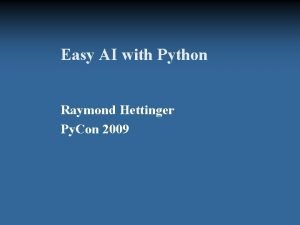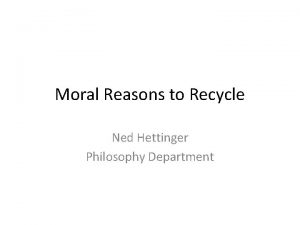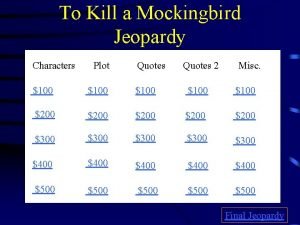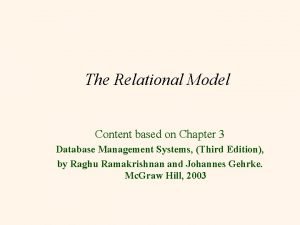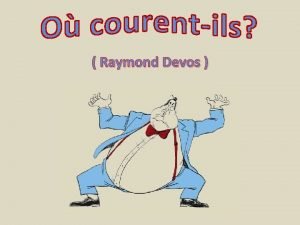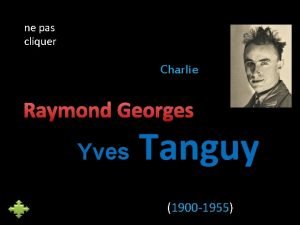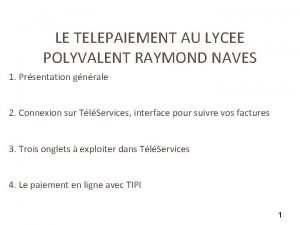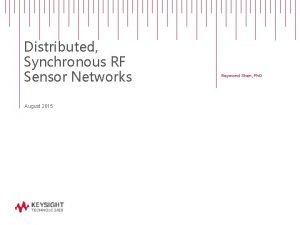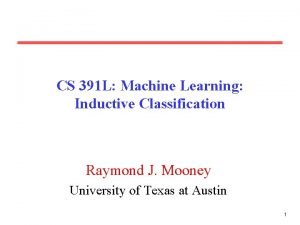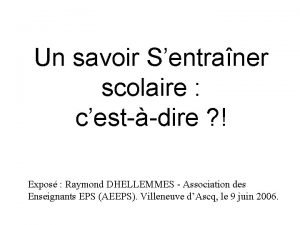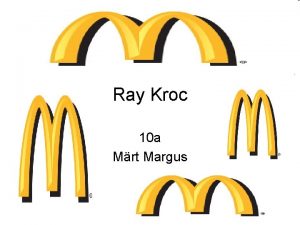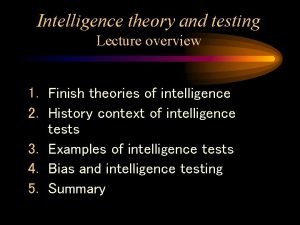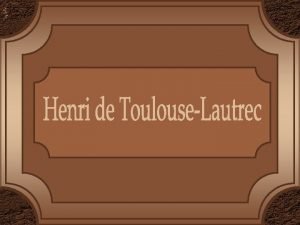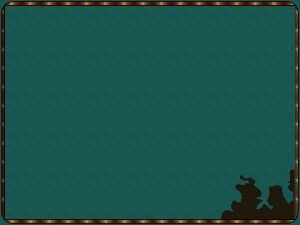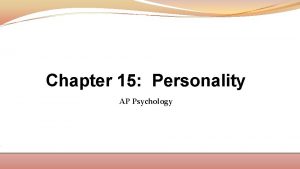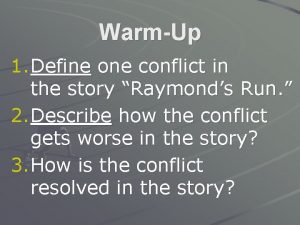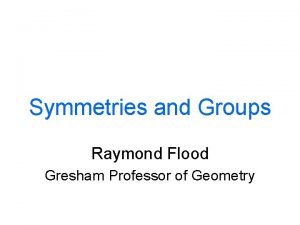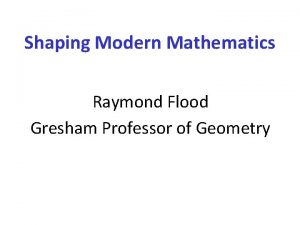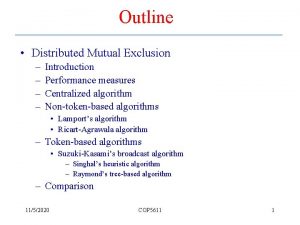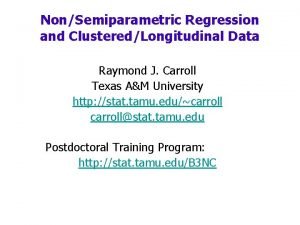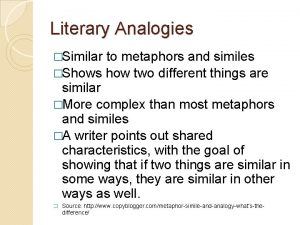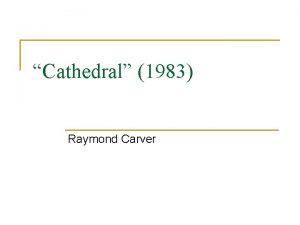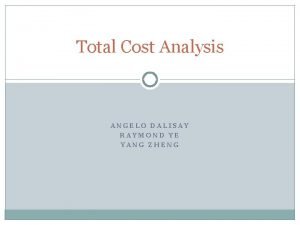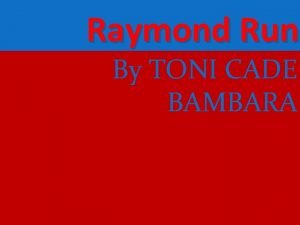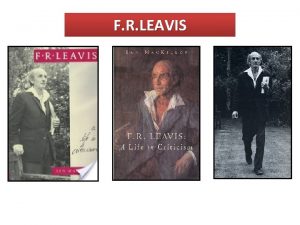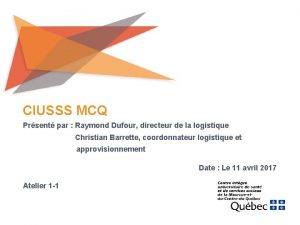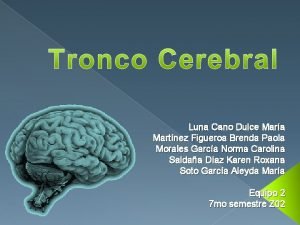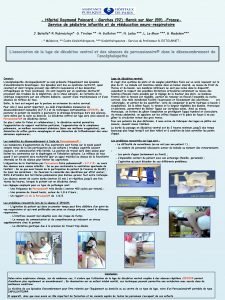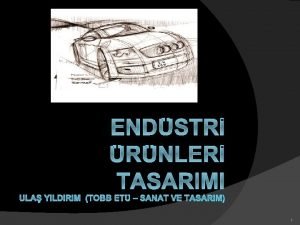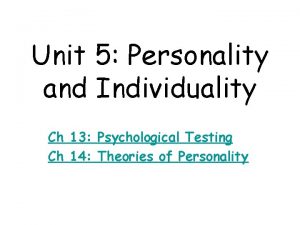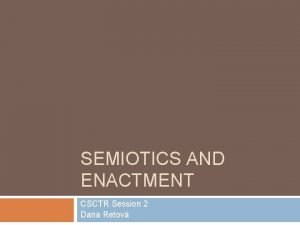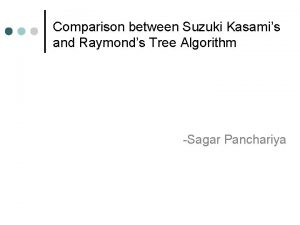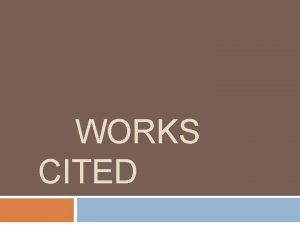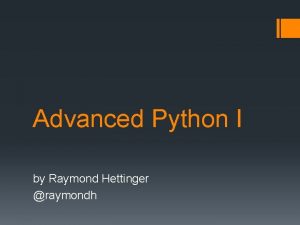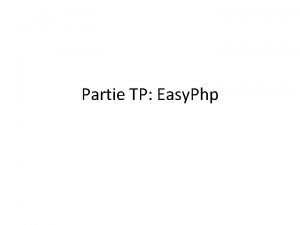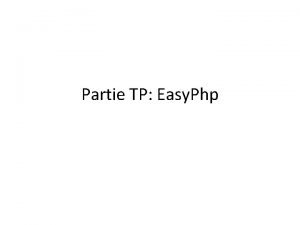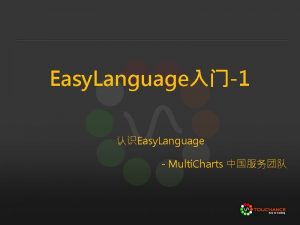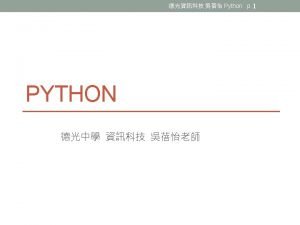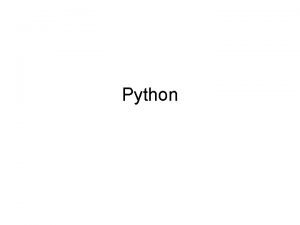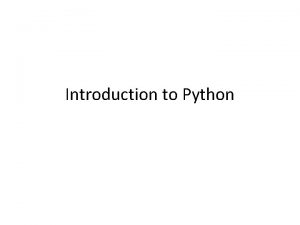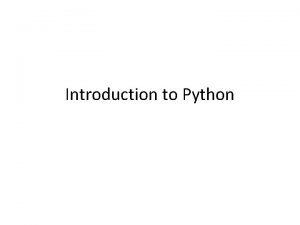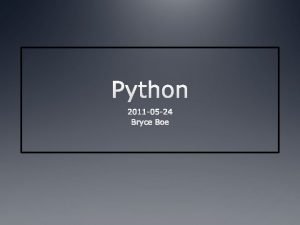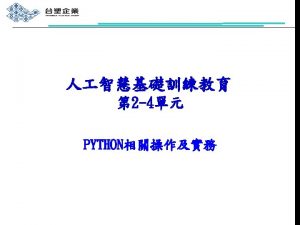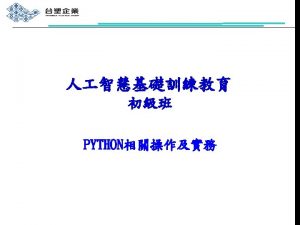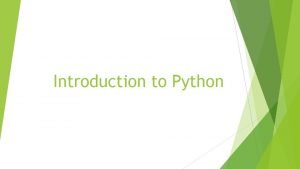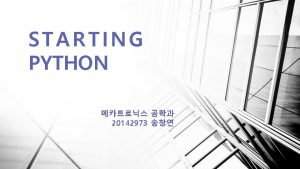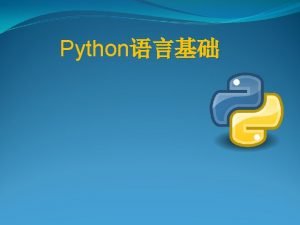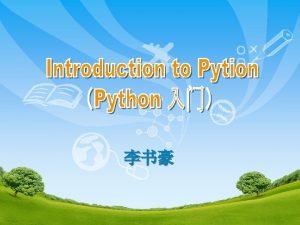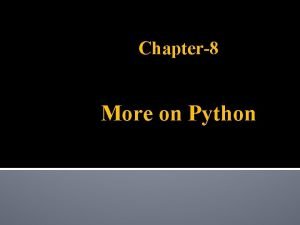Easy AI with Python Raymond Hettinger Py Con






![Alphametics Solver – Recipe 576647 def solve(s): words = findall('[A-Za-z]+', s) chars = set(''. Alphametics Solver – Recipe 576647 def solve(s): words = findall('[A-Za-z]+', s) chars = set(''.](https://slidetodoc.com/presentation_image_h/2bc4b72f9c49a66b9a9567ac54ef8ce1/image-7.jpg)












![Pool class Pool(object): __slots__ = ['sum', 'members'] def __init__(self): self. sum = 0. 0 Pool class Pool(object): __slots__ = ['sum', 'members'] def __init__(self): self. sum = 0. 0](https://slidetodoc.com/presentation_image_h/2bc4b72f9c49a66b9a9567ac54ef8ce1/image-20.jpg)















































![Code for the solver def solve( pos, depth. First=0 ): queue, trail = deque([pos]), Code for the solver def solve( pos, depth. First=0 ): queue, trail = deque([pos]),](https://slidetodoc.com/presentation_image_h/2bc4b72f9c49a66b9a9567ac54ef8ce1/image-68.jpg)




























- Slides: 96

Easy AI with Python Raymond Hettinger Py. Con 2009

Themes • • • Easy! Short! General purpose tools – easily adaptable Great for teaching Python Hook young minds with truly interesting problems.

Topics: 1. Exhaustive search using new itertools 2. Database mining using neural nets 3. Automated categorization with a naive Bayesian classifier 4. Solving popular puzzles with depth-first and breath-first searches 5. Solving more complex puzzles with constraint propagation 6. Play a popular game using a probing search strategy

Eight Queens – Six Lines http: //code. activestate. com/recipes/576647/ from itertools import permutations n = 8 cols = range(n) for vec in permutations(cols): if (n == len(set(vec[i]+i for i in cols)) == len(set(vec[i]-i for i in cols))): print vec

Alphametics Solver >>> solve('SEND + MORE == MONEY') 9567 + 1085 == 10652

• • • • • • • 'VIOLIN * 2 + VIOLA == TRIO + SONATA', 'SEND + A + TAD + MORE == MONEY', 'ZEROES + ONES == BINARY', 'DCLIZ + DLXVI == MCCXXV', 'COUPLE + COUPLE == QUARTET', 'FISH + N + CHIPS == SUPPER', 'SATURN + URANUS + NEPTUNE + PLUTO == PLANETS', 'EARTH + AIR + FIRE + WATER == NATURE', ('AN + ACCELERATING + INFERENTIAL + ENGINEERING + TALE + 'ELITE + GRANT + FEE + ET + CETERA == ARTIFICIAL + INTELLIGENCE'), 'TWO * TWO == SQUARE', 'HIP * HIP == HURRAY', 'PI * R ** 2 == AREA', 'NORTH / SOUTH == EAST / WEST', 'NAUGHT ** 2 == ZERO ** 3', 'I + THINK + IT + BE + THINE == INDEED', 'DO + YOU + FEEL == LUCKY', 'NOW + WE + KNOW + THE == TRUTH', 'SORRY + TO + BE + A + PARTY == POOPER', 'SORRY + TO + BUST + YOUR == BUBBLE', 'STEEL + BELTED == RADIALS', 'ABRA + CADABRA == HOUDINI', 'I + GUESS + THE + TRUTH == HURTS', 'LETS + CUT + TO + THE == CHASE', 'THATS + THEORY == ANYWAY',
![Alphametics Solver Recipe 576647 def solves words findallAZaz s chars set Alphametics Solver – Recipe 576647 def solve(s): words = findall('[A-Za-z]+', s) chars = set(''.](https://slidetodoc.com/presentation_image_h/2bc4b72f9c49a66b9a9567ac54ef8ce1/image-7.jpg)
Alphametics Solver – Recipe 576647 def solve(s): words = findall('[A-Za-z]+', s) chars = set(''. join(words)) assert len(chars) <= 10 firsts = set(w[0] for w in words) chars = ''. join(firsts) + ''. join(chars - firsts) n = len(firsts) for perm in permutations('0123456789', len(chars)): if '0' not in perm[: n]: trans = maketrans(chars, ''. join(perm)) equation = s. translate(trans) if eval(equation): print equation

Neural Nets for Data-Mining • ASPN Cookbook Recipe: 496908 • Parallel Distributed Processing: IAC example

What is the core concept? • A database can be modeled as a brain (neural net) • Unique field values in the database are neurons • Table rows define mutually excitory connections • Table columns define competing inhibitory connections

How do you use it? • Provide a stimulus to parts of the neural net • Then see which neurons get activated the most

The Human Brain

Neurons, Axons, Synapses

What can this do that SQL can’t? • Make generalizations • Survive missing data • Extrapolate to unknown instances

Jets and Sharks example Art Al Sam Clyde Mike Jets Jets 40 30 20 40 30 jh jh col jh jh sing mar sing pusher burglar bookie 40 30 30 hs hs col hs hs mar div mar sing div burglar pusher bookie pusher . . . Earl Rick Ol Neal Dave Sharks Sharks

Neuron for Every unique value in the database Art, Al, Sam, Jets, Sharks, 20, 30, 40, pusher, bookie. . . • All neurons start in a resting state • Excited by neural connections – defined by the table rows • Inhibited by other neurons in the same pool – defined by table columns • Can also be excited or inhibited externally – probes into the database

Generalizing from a specific instance • touch('Ken', weight=0. 8) Ken: 0. 82 Nick: 0. 23 Neal: 0. 23 Rick: 0. 03 Earl: 0. 03 Pete: 0. 03 Fred: 0. 03 Sharks: 0. 53 Jets: -0. 13 20: 0. 41 30: -0. 05 40: -0. 13 hs: 0. 54 jh: -0. 14 col: -0. 14 sing: 0. 53 mar: -0. 13 div: -0. 13 burglar: 0. 41 pusher: -0. 11 bookie: -0. 11

Query the neural net for given facts • touch('Sharks 20 jh sing burglar') Ken: 0. 54 Lance: 0. 47 John: 0. 47 Jim: 0. 47 George: 0. 47 Sharks: 0. 78 Jets: 0. 48 20: 0. 85 30: -0. 15 40: -0. 15 jh: 0. 84 hs: -0. 12 col: -0. 15 sing: 0. 80 mar: 0. 02 div: 0. 02 burglar: 0. 85 bookie: -0. 15 pusher: -0. 15

Compensate for missing data • touch('Lance') • depair('Lance', 'burglar') Lance: 0. 82 John: 0. 54 Jim: 0. 30 George: 0. 30 Al: 0. 26 Jets: 0. 66 Sharks: -0. 14 20: 0. 63 30: -0. 13 40: -0. 14 jh: 0. 66 hs: -0. 14 col: -0. 14 mar: 0. 58 div: -0. 08 sing: -0. 14 burglar: 0. 54 pusher: -0. 14 bookie: -0. 14

Neuron class Unit(object): def __init__(self, name, pool): self. name = name self. pool = pool self. reset() self. exciters = [] unitbyname[name] = self def computenewact(self): ai = self. activation plus = sum(exciter. output for exciter in self. exciters) minus = self. pool. sum - self. output netinput = alpha*plus - gamma*minus + estr*self. extinp if netinput > 0: ai = (maxact-ai)*netinput - decay*(ai-rest) + ai else: ai = (ai-minact)*netinput - decay*(ai-rest) + ai self. newact = max(min(ai, maxact), minact)
![Pool class Poolobject slots sum members def initself self sum 0 0 Pool class Pool(object): __slots__ = ['sum', 'members'] def __init__(self): self. sum = 0. 0](https://slidetodoc.com/presentation_image_h/2bc4b72f9c49a66b9a9567ac54ef8ce1/image-20.jpg)
Pool class Pool(object): __slots__ = ['sum', 'members'] def __init__(self): self. sum = 0. 0 self. members = set() def addmember(self, member): self. members. add(member) def updatesum(self): self. sum = sum(member. output for member in self. members)

Engine def run(times=100): """Run n-cycles and display result""" for i in xrange(times): for pool in pools: pool. updatesum() for unit in units: unit. computenewact() for unit in units: unit. commitnewact() print '-' * 20 for pool in pools: pool. display()

What have we accomplished: • 100 lines of Python models any database as neural net • Probing the brain reveals or confirms hidden relationships

Mastermind • Mastermind-style Games • Making smart probes into a search space • ASPN Cookbook Recipe: 496907

What is Mastermind? • • A codemaker picks a 4 -digit code: (4, 3, 3, 7) The codebreaker makes a guess: (3, 3, 2, 4) The codemaker scores the guess: (1, 2) The codebreaker uses the information to make better guesses • There are many possible codebreaking strategies • Better strategies mean that fewer guesses are needed

What is the interesting part? • Experimenting with different strategies to find the best • Finding ways to make it fast

The basic code takes only 30 lines: import random from itertools import izip, imap digits = 4 fmt = '%0' + str(digits) + 'd' searchspace = tuple([tuple(map(int, fmt % i)) for i in range(0, 10**digits)]) def compare(a, b, map=imap, sum=sum, zip=izip, min=min): count 1 = [0] * 10 count 2 = [0] * 10 strikes = 0 for dig 1, dig 2 in zip(a, b): if dig 1 == dig 2: strikes += 1 count 1[dig 1] += 1 count 2[dig 2] += 1 balls = sum(map(min, count 1, count 2)) - strikes return (strikes, balls)

(Continued) def rungame(target, strategy, maxtries=15): possibles = list(searchspace) for i in xrange(maxtries): g = strategy(i, possibles) print "Out of %7 d possibilities. I'll guess %r" % (len(possibles), g), score = compare(g, target) print ' ---> ', score if score[0] == digits: print "That's it. After %d tries, I won. " % (i+1, ) break possibles = [n for n in possibles if compare(g, n) == score] return i+1

(Continued) def s_allrand(i, possibles): 'Simple strategy that randomly chooses one remaining possibility' return random. choice(possibles) hiddencode = (4, 3, 3, 7) rungame(hiddencode, s_allrand)

Step 1: List out the search space digits = 4 fmt = '%0' + str(digits) + 'd‘ searchspace = tuple([tuple(map(int, fmt % i)) for i in range(0, 10**digits)])

This creates a sequence of all possible plays: (0, 0, 0, 0), (0, 0, 0, 1), (0, 0, 0, 2), . . . (9, 9, 9, 9),

Step 2: Build the scoring function def compare(a, b, map=imap, sum=sum, zip=izip, min=min): count 1 = [0] * 10 count 2 = [0] * 10 strikes = 0 for dig 1, dig 2 in zip(a, b): if dig 1 == dig 2: strikes += 1 count 1[dig 1] += 1 count 2[dig 2] += 1 balls = sum(map(min, count 1, count 2)) - strikes return (strikes, balls)

Step 3: Devise a strategy for choosing the next move def s_allrand(i, possibles): 'Simple strategy that randomly chooses one possibility' return random. choice(possibles)

Step 4: Make an engine to run the game • • Start with a full search space Let the strategy pick a probe Score the result Pare down the search space using the score

Step 5: Run it! hiddencode = (4, 3, 3, 7) rungame(hiddencode, s_allrand)

• • Out of 10000 possibilities. I'll guess (0, 0, 9, 3) ---> (0, 1) Out of 3052 possibilities. I'll guess (9, 4, 4, 8) ---> (0, 1) Out of 822 possibilities. I'll guess (8, 3, 8, 5) ---> (1, 0) Out of 123 possibilities. I'll guess (3, 3, 2, 4) ---> (1, 2) Out of 6 possibilities. I'll guess (4, 3, 3, 6) ---> (3, 0) Out of 2 possibilities. I'll guess (4, 3, 3, 1) ---> (3, 0) Out of 1 possibilities. I'll guess (4, 3, 3, 7) ---> (4, 0) That's it. After 7 tries, I won.

Step 6: Make it fast • psyco gives a 10: 1 speedup • code the compare() function in C

Step 7: Experiment with a new strategy • If possible, make a guess with no duplicates def s_trynodup(i, possibles): for j in xrange(20): g = random. choice(possibles) if len(set(g)) == digits: break return g

Step 8: Try a smarter strategy: The utility of a guess is how well it divides-up the remaining possibilities def utility(play, possibles): b = {} for poss in possibles: score = compare(play, poss) b[score] = b. get(score, 0) + 1 return info(b. values())

(Continued) The information content of that division is given by Shannon’s formula def info(seqn): bits = 0 s = float(sum(seqn)) for i in seqn: p = i / s bits -= p * log(p, 2) return bits

(Continued) Select the probe with the greatest information content def s_bestinfo(i, possibles): if i == 0: return s_trynodup(i, possibles) plays = random. sample(possibles, min(20, len(possibles))) _, play = max([(utility(play, possibles), play) for play in plays]) return play

Step 9: Make it fast Instead of evaluating the utility of every move, pick the best of a small sample: def s_samplebest(i, possibles): if i == 0: return s_trynodup(i, possibles) if len(possibles) > 150: possibles = random. sample(possibles, 150) plays = possibles[: 20] elif len(possibles) > 20: plays = random. sample(possibles, 20) else: plays = possibles _, play = max([(utility(play, possibles), play) for play in plays]) return play

Step 10: Bask in the glow of your model: • • The basic framework took only 30 lines of code Four different strategies took another 30 It’s easy to try out even more strategies The end result is not far from theoretical optimum

Sudoku-style Puzzles • • An exercise in constraint propagation ASPN Cookbook Recipe Google for: sudoku norvig Wikipedia entry: sudoku

What does a Sudoku puzzle look like? 27 | 15| 8 |3 |7 4 | 7 | ---+--5 |1 | 7 9| |2 6 | 2| 5 ---+--| 8 | 6 5| 4| 8 |59 | 41

What does a Sudoku puzzle look like when it is solved 276|415|938 581|329|764 934|876|512 ---+--352|168|479 149|753|286 768|942|153 ---+--497|681|325 615|234|897 823|597|641

What is the interesting part? • Use constraints to pare-down an enormous search-space • Finding various ways to propagate constraints • Enjoy the intellectual challenge of the puzzles without wasting time • Complete code takes only 56 lines (including extensive comments)

Step 1: Choose a representation and a way to display it '53 7 28 6 195 419 5 98 6 8 8 79‘ 6 34 8 3 17 2 6 6 def show(flatline): 'Display grid from a string (values in row major order with blanks for unknowns)' fmt = '|'. join(['%s' * n] * n) sep = '+'. join(['-' * n] * n) for i in range(n): for j in range(n): offset = (i*n+j)*n 2 print fmt % tuple(flatline[offset: offset+n 2]) if i != n-1: print sep

Step 2: Determine which cells are in contact with each other def _find_friends(cell): 'Return tuple of cells in same row, column, or subgroup' friends = set() row, col = cell // n 2, cell % n 2 friends. update(row * n 2 + i for i in range(n 2)) friends. update(i * n 2 + col for i in range(n 2)) nw_corner = row // n * n 3 + col // n * n friends. update(nw_corner + i + j for i in range(n) for j in range(0, n 3, n 2)) friends. remove(cell) return tuple(friends) friend_cells = map(_find_friends, range(n 4))

Step 3: Write a solver def solve(possibles, pending_marks): # Apply pending_marks (list of cell, value pairs) to possibles (list of str). # Mutates both inputs. Return solution as a flat string (values in row-major order) # or return None for dead-ends where all possibilites have been eliminated. for cell, v in pending_marks: possibles[cell] = v for f in friend_cells[cell]: p = possibles[f] if v in p: p = possibles[f] = p. replace(v, '') # exclude value v from friend f if not p: return None # Dead-end: all possibilities eliminated if len(p) == 1: pending_marks. append((f, p[0]))

(Continued) # Check to see if the puzzle is fully solved (each cell has only one possible value) if max(map(len, possibles)) == 1: return ''. join(possibles) # If it gets here, there are still unsolved cells cell = select_an_unsolved_cell(possibles) for v in possibles[cell]: # try all possible values for that cell ans = solve(possibles[: ], [(cell, v)]) if ans is not None: return ans

Hey, what did that solver do again? • Makes an assumption about a cell • Goes to each of the friend_cells and eliminates that possibility • Check to see if the puzzle is solved • If some cell goes down to one possibility, repeat the process • If some cells are unsolved, make another assumption

Step 4: Pick a search strategy: def select_an_unsolved_cell(possibles, heuristic=min): # Default heuristic: select cell with fewest possibilities # Other possible heuristics include: random. choice() and max() return heuristic((len(p), cell) for cell, p in enumerate(possibles) if len(p)>1)[1]

Here’s where it gets fun. Step 5: Bask in the glow of your model: • The basic framework took only 56 lines of code • It’s easy to try-out alternative search heuristics • The end result solves “hard” puzzles with very little guesswork • It’s easy to generate all possible solutions • The framework can be extended for other ways to propagate constraints • See the wikipedia entry for other solution techniques

Bayesian Classifier • Google for: reverend thomas python • Or link to: http: //www. divmod. org/projects/reverend

Principle • Use training data (a corpus) to compute conditional probabilities • Given some attribute, what is the conditional probability of a given classification • Now, given many attributes, combine those probabilities • Done right, you have to know joint probabilities • But if you ignore those, it tends to work out just fine

Example • • • Guess which decade a person was born Attribute 1 – the person’s name is Gertrude Attribute 2 – their favorite dance is the Foxtrot Attribute 3 – the person lives in the Suburbs Attribute 4 – the person drives a Buick Regal • We don’t know the joint probabilities, but can gather statistics on each on by itself.

Tricks of the trade • Since we’ve thrown exact computation away, what is the best approximation • The simplest way is to multiply the conditional probabilities • The conditionals can be biased by a count of one to avoid multiplying by zero • The information content can be estimated using the Claude Shannon formula • The probabilities can be weighted by significance • and so on . . .

Coding it in Python • Conceptually simple • Just count attributes in the corpus to compute the conditional probabilities • Just multiply (or whatever) the results for each attribute • Pick the highest probability result • Complexity comes from effort to identify attributes (parsing, tokenizing, etc)

Language classification example >>> from reverend. thomas import Bayes >>> guesser = Bayes() >>> guesser. train('french', 'le la les du un une je il elle de en') >>> guesser. train('german', 'der die das eine') >>> guesser. train('spanish', 'el uno una las de la en') >>> guesser. train('english', 'the it she he they them are were to') >>> guesser. guess('they went to el cantina')spanish >>> guesser. guess('they were flying planes')english

The hot topic • Classifying email as spam or ham • Simple example using reverend. thomas • Real-world example with spambayes

Generic Puzzle Solving Framework Depth-first and breadth-first tree searches • Link to: http: //users. rcn. com/python/download/puzzle. py • Google for: puzzle hettinger • Wikipedia: depth-first search

What does a generic puzzle look like? • • There an initial position There is a rule for generating legal moves There is a test for whether a state is a goal Optionally, there is a way to pretty print the current state

Initial position for the Golf-Tee Puzzle 0 1 1 1 1 1

Legal move Jump over an adjacent tee and removing the jumped tee 1 0 1 1 1 1 1

Goal state 1 0 0 0 0 0

Code for the puzzle class Golf. Tee( Puzzle ): pos = '01111111' goal = '10000000' triples = [[0, 1, 3], [1, 3, 6], [3, 6, 10], [2, 4, 7], [4, 7, 11], [5, 8, 12], [10, 11, 12], [11, 12, 13], [12, 13, 14], [6, 7, 8], [7, 8, 9], [3, 4, 5], [0, 2, 5], [2, 5, 9], [5, 9, 14], [1, 4, 8], [4, 8, 13], [3, 7, 12]] def __iter__( self ): for t in self. triples: if self. pos[t[0]]=='1' and self. pos[t[1]]=='1' and self. pos[t[2]]=='0': yield Tri. Puzzle(self. produce(t, '001')) if self. pos[t[0]]=='0' and self. pos[t[1]]=='1' and self. pos[t[2]]=='1': yield Tri. Puzzle(self. produce(t, '100')) def produce( self, t, sub ): return self. pos[: t[0]] + sub[0] + self. pos[t[0]+1: t[1]] + sub[1] + self. pos[t[1]+1: t[2]] + sub[2] + self. pos[t[2]+1: ] def canonical( self ): return self. pos def __repr__( self ): return 'n % sn %s %s %sn%s %s %sn' % tuple(self. pos)

How does the solver work? • • Start at the initial position Generate legal moves Check each to see if it is a goal state If not, then generate the next legal moves and repeat
![Code for the solver def solve pos depth First0 queue trail dequepos Code for the solver def solve( pos, depth. First=0 ): queue, trail = deque([pos]),](https://slidetodoc.com/presentation_image_h/2bc4b72f9c49a66b9a9567ac54ef8ce1/image-68.jpg)
Code for the solver def solve( pos, depth. First=0 ): queue, trail = deque([pos]), {pos. canonical(): None} solution = deque() load = depth. First and queue. append or queue. appendleft while not pos. isgoal(): for m in pos: c = m. canonical() if c in trail: continue trail[c] = pos load(m) pos = queue. pop() while pos: solution. appendleft( pos) pos = trail[pos. canonical()] return solution

0 1 1 1 1 1

1 0 1 1 1 1 1

1 0 1 1 0 0 1 1 1

1 1 1 0 0 1 1 1

0 0 1 1 0 0 0 1 1 1

0 0 1 1 1 0 0 0 1 1 1 0 1 1 1

0 0 1 1 1 0 0 0 1 1 0 0 1

0 0 1 1 1 0 0 0 1 1 0 0 1

0 0 1 1 1 1 0 0

0 0 0 1 1 0 0 0 1 1 0 0 1 0 0

0 0 0 1 1 1 0 0 0 1 0 0 0

0 0 1 1 1 0 0 0

0 0 1 0 0 0

1 0 0 0 0 0

How about Jug Filling Puzzle Given a two empty jugs with 3 and 5 liter capacities and a full jug with 8 liters, find a sequence of pours leaving four liters in the two largest jugs

What does the code look like? class Jug. Fill( Puzzle ): pos = (0, 0, 8) capacity = (3, 5, 8) goal = (0, 4, 4) def __iter__(self): for i in range(len(self. pos)): for j in range(len(self. pos)): if i==j: continue qty = min(self. pos[i], self. capacity[j] - self. pos[j]) if not qty: continue dup = list( self. pos ) dup[i] -= qty dup[j] += qty yield Jug. Fill(tuple(dup))

What does the solution look like: (0, 0, 8) (0, 5, 3) Pour the 8 into the 5 until it is full leaving 3 (3, 2, 3) Pour the 5 into the 2 until it is full leaving 2 (0, 2, 6) Pour the 3 into the other the totaling 6 (2, 0, 6) Pour the 2 into the empty jug (2, 5, 1) Pour the 6 into the 5 leaving 1 (3, 4, 1) Pour the 5 into the 3 until full leaving 4 (0, 4, 4) Pour the 1 into the 3 leaving 4

How about a black/white marble jumping puzzle? Given eleven slots in a line with four white marbles in the leftmost slots and four black marbles in the rightmost, make moves to put the white ones on the right and the black on the left. A valid move for a while marble isto shift right into an empty space or hop over a single adjacent black marble into an adjacent empty space -- don't hop over your own color, don't hop into an occupied space, don't hop over more than one marble. The valid black moves are in the opposite direction. Alternate moves between black and white marbles.

(Continued) In the tuple representation below, zeros are open holes, ones are whites, negative ones are blacks, and the outer tuple track whether it is whites move or blacks.

The code is straight-forward: pos = (1, 1, 0, 0, 0, -1, -1)) goal = (-1, -1, 0, 0, 0, 1, 1) def isgoal( self ): return self. pos[1] == self. goal def __iter__( self ): (m, b) = self. pos for i in range(len(b)): if b[i] != m: continue if 0<=i+m+m<len(b) and b[i+m] == 0: newmove = list(b) newmove[i] = 0 newmove[i+m] = m yield Marble. Puzzle((-m, tuple(newmove ))) elif 0<=i+m+m<len(b) and b[i+m]==-m and b[i+m+m]==0: newmove = list(b) newmove[i] = 0 newmove[i+m+m] = m yield Marble. Puzzle((-m, tuple(newmove )))

What does the solution look like? [wwww. . . bbbb, wwww. . b. bbb, www. wb. . bbb, ww. wwb. . bbb, ww. wwb. b. bb, ww. w. bwb. bb, ww. wb. bb, ww. . bwwb. bb, ww. bwbb, wwb. . w. bwbb, w. bw. wbb, . wbw. wbb, bw. w. wbb, b. ww. wbb, b. wwbw. . wbb, b. wwb. wbw. b, b. w. bwwbw. b, b. w. bwwbwb. , b. w. bwwb. bw, b. wwb. bw, b. w. bwbw, bbw. . . wbwbw, bbw. wbw, bb. w. bw. wbw, bb. w. bwbw. w, bb. . wbwbw. w, bb. bw. w, bb. bw. wb. ww, bbb. w. . bwww, bbb. www, bbb. . wb. www, bbb. bw. . www, bbb. b. w. www, bbbb. . w. www,

How about a sliding block puzzle? 1122 1133 45. . 6788 6799

(Continued) 7633 7622. . 54 1199 1188

Sliding Block Code class Sliding( Puzzle ): pos = '11221133450067886799' goal = re. compile( r'. . . . 1. . . ' ) def isgoal(self): return self. goal. search(self. pos ) != None def __repr__( self ): ans = 'n' pos = self. pos. replace( '0', '. ' ) for i in [0, 4, 8, 12, 16]: ans = ans + pos[i: i+4] + 'n' return ans xlat = string. maketrans('38975', '22264') def canonical( self ): return self. pos. translate( self. xlat ) block = { (0, -4): None, (1, -4): None, (2, -4): None, (3, -4): None, (16, 4): None, (17, 4): None, (18, 4): None, (19, 4): None, (0, -1): None, (4, -1): None, (8, -1): None, (12, -1): None, (16, -1): None, (3, 1): None, (7, 1): None, (11, 1): None, (15, 1): None, (19, 1): None, }

(Continued) def __iter__( self ): dsone = self. pos. find('0') dstwo = self. pos. find('0', dsone+1) for dest in [dsone, dstwo]: for adj in [-4, -1, 1, 4]: if (dest, adj) in self. block: continue piece = self. pos[dest+adj] if piece == '0': continue newmove = self. pos. replace(piece, '0') for i in range(20): if 0 <= i+adj < 20 and self. pos[i+adj]==piece: newmove = newmove[: i] + piece + newmove[i+1: ] if newmove. count('0') != 2: continue yield Pa. Puzzle(newmove)

What have we accomplished? • • A 36 line generic puzzle solving framework Easy adapted to a huge variety of puzzles The fun part is writing the move generator Everything else is trivial (initial position, goal state, repr function)

Optimizing • Fold symmetries into a single canonical states (don’t explore mirror image solutions) • Use collections. deque() instead of a list() • Decide between depth-first and breadthfirst solutions. (first encountered vs shortest solution)

Q&A
 Raymond hettinger wikipedia
Raymond hettinger wikipedia Ned hettinger
Ned hettinger Ned hettinger
Ned hettinger Ned hettinger
Ned hettinger No mayten tree is deciduous
No mayten tree is deciduous Deductive method
Deductive method Example of deductive reasoning
Example of deductive reasoning Khi tình yêu con còn mơ tin yêu con dệt thơ
Khi tình yêu con còn mơ tin yêu con dệt thơ Nobody said anything raymond carver
Nobody said anything raymond carver Carver middle school dress code
Carver middle school dress code Dolphus raymond quotes
Dolphus raymond quotes Raymond boyce and donald chamberlin
Raymond boyce and donald chamberlin Dyberport
Dyberport Raymond moffatt
Raymond moffatt Raymond's run characters
Raymond's run characters Raymond's run text
Raymond's run text Raymond's run author
Raymond's run author Raymond james stuart
Raymond james stuart Raymond devos courir
Raymond devos courir Allport's trait theory
Allport's trait theory Mintzberg outlined three categories of managerial roles:
Mintzberg outlined three categories of managerial roles: Notes on deconstructing the popular summary
Notes on deconstructing the popular summary Raymond georges yves tanguy
Raymond georges yves tanguy Ent lycee raymond naves
Ent lycee raymond naves Raymond inmon wikipedia
Raymond inmon wikipedia Danielle clahar-raymond
Danielle clahar-raymond Raymond buys
Raymond buys Civics.360
Civics.360 Raymond begg
Raymond begg Raymond shen
Raymond shen Cs391l
Cs391l Raymond carver alcoholism
Raymond carver alcoholism Rocog
Rocog Raymond xie
Raymond xie What is pop culture
What is pop culture Raymond dhellemmes
Raymond dhellemmes How does scout react to francis taunts
How does scout react to francis taunts Raymond cox qc
Raymond cox qc Culture is ordinary summary
Culture is ordinary summary Raymond b stewart middle school
Raymond b stewart middle school Margus veri
Margus veri Raymond chi-wing wong
Raymond chi-wing wong Programme de tlvision ce soir
Programme de tlvision ce soir Summary of intelligence
Summary of intelligence Henri marie raymond
Henri marie raymond Claude jacquemay
Claude jacquemay Freudian personality types
Freudian personality types Tragedy and contemporary ideas
Tragedy and contemporary ideas The lesson by toni cade bambara conflict
The lesson by toni cade bambara conflict Raymond simon contact info
Raymond simon contact info Hungary rtir
Hungary rtir Königsberg
Königsberg Professor raymond flood
Professor raymond flood Singhals heuristic algorithm
Singhals heuristic algorithm Raymond carlsen
Raymond carlsen Raymond carroll tamu
Raymond carroll tamu Similes in raymond's run
Similes in raymond's run Joseph pasteur
Joseph pasteur Joseph raymond conniff
Joseph raymond conniff Raymond bras
Raymond bras Raymond chandler cathedral
Raymond chandler cathedral Ethics definition
Ethics definition Ciusss mcq guichet
Ciusss mcq guichet Raymond ye
Raymond ye St raymond elementary school uniform
St raymond elementary school uniform Raymonds run setting
Raymonds run setting Raymond albert kroc
Raymond albert kroc Dato raymond liew
Dato raymond liew Ilan raymond
Ilan raymond Raymond kim uhn
Raymond kim uhn Hemoglobinapathies
Hemoglobinapathies Is an analogy figurative language
Is an analogy figurative language Frank raymond leavis
Frank raymond leavis Raymond dufour ciusss mcq
Raymond dufour ciusss mcq Chemistry by raymond chang 10th edition
Chemistry by raymond chang 10th edition Yann mikaeloff
Yann mikaeloff Raymond wong cityu
Raymond wong cityu Phython
Phython David hesmondhalgh theory
David hesmondhalgh theory Raymond chandler 1939
Raymond chandler 1939 Ollie raymond
Ollie raymond Oakton high school athletics
Oakton high school athletics Raymond jiang
Raymond jiang Raymond liao
Raymond liao Hemiparesia motora pura
Hemiparesia motora pura Raymond williams analysis of culture
Raymond williams analysis of culture Raymond ackerman academy
Raymond ackerman academy Raymond poincar
Raymond poincar Cubismo
Cubismo Tobb endüstriyel tasarım
Tobb endüstriyel tasarım Raymond cattell was a psychologist who ________.
Raymond cattell was a psychologist who ________. Grey walter
Grey walter Raymond najjar
Raymond najjar Raymond's tree based algorithm
Raymond's tree based algorithm Work cited page
Work cited page Easy topic about life
Easy topic about life Surat tasmiyah
Surat tasmiyah
